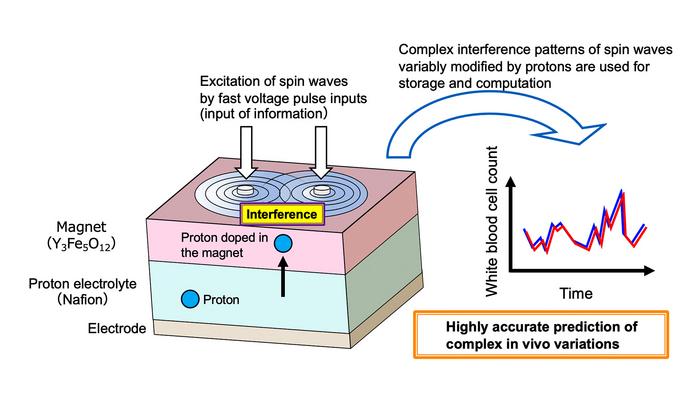In a groundbreaking advancement that pushes the boundaries of artificial intelligence technology, a collaborative research endeavor led by the National Institute for Materials Science (NIMS) and the Japan Fine Ceramics Center (JFCC) has unveiled a pioneering AI device featuring an iono-magnonic reservoir. This device distinctly exemplifies a significant upgrade in the existing physical reservoir computing systems by utilizing spin waves—collective excitations inherent to the electron spins found in magnetic materials. The research team successfully demonstrated that their novel hardware component can outperform traditional devices in terms of information processing capability, hinting at transformative implications for the future of AI technologies.
As the evolution of artificial intelligence devices progresses, the global demand for energy-efficient and high-performance computational solutions is burgeoning. Recognizing this need, the research group focused on developing a device that harnesses the properties of yttrium iron garnet (YIG) magnets, a material that serves a pivotal role in generating spin waves. By utilizing antennas that are embedded in these YIG magnets, the team was able to fine-tune the interference patterns of the produced spin waves. This tunable property is critical as it allows for direct control over the dynamics of the iono-magnonic reservoir, enabling enhanced computational performance.
With the functionality of the device hinging on the manipulation of spin waves, the researchers employed varying voltage levels applied to the YIG magnets, along with controlling the number of ions present in the system. This intricate process allows for the creation of dynamic interference patterns that greatly improve the device’s computational reach. By successfully executing computations based on these advanced interference patterns, the device showcases capabilities that exceed those of conventional physical reservoir computing devices by a notable margin.
One of the most impressive feats achieved by the new device is its remarkable proficiency in time-series prediction tasks. In tests, the AI device produced error rates that were less than one-tenth of those recorded by traditional devices. To validate the prediction accuracy, the researchers employed a recognized evaluation protocol rooted in Mackey-Glass equations, which are frequently utilized to model and analyze the complex variations typical within biological systems. The results underscored the device’s potential to handle intricate and dynamic datasets with unprecedented efficacy.
The implications of this research extend beyond theoretical applications, as the novel AI device can be implemented across various platforms and materials. It demonstrates compatibility with both magnetic thin films and single crystals, facilitating miniaturization without compromising performance. This versatility in implementation positions the technology as a frontrunner for integration into industrial applications, ranging from sensors to computational systems in highly specialized fields.
Moreover, the collaborative effort of the research team showcases a blend of expertise, including experts like Takashi Tsuchiya, who led the Neuromorphic Devices Group at NIMS. His guidance, coupled with insights from researchers like Wataru Namiki and Kazuya Terabe, fueled the progress and innovation driving this project. Each member brought unique skills in neuromorphic and ionic device technology, which elevated the team’s capabilities to create a device of such promising value.
This project received significant support from the National Security Technology Research Promotion Fund, highlighting the importance and potential applications of the research funded by the Acquisition, Technology & Logistics Agency under Japan’s Ministry of Defense. Such backing not only underscores the strategic relevance of developing advanced AI technologies but also signals the commitment to fostering innovation within this critical sector.
The team’s findings and the intricate workings of the iono-magnonic reservoir computing device have been documented in detail in Advanced Science, an open-access journal known for disseminating pivotal research. Published on November 17, 2024, this research contributes a vital chapter to the growing body of knowledge surrounding AI hardware advancements.
In conclusion, the advent of the iono-magnonic reservoir computing device signifies a leap forward in computational capabilities within artificial intelligence. The device’s efficacy in time-series prediction combined with its sustainable energy profile makes it an exciting prospect for industries reliant on advanced computation. As research progresses and more applications are identified, this technology may very well revolutionize the landscape of AI, creating pathways previously thought unattainable.
Ultimately, this novel AI device stands not only as a technological marvel but also represents a collaborative pursuit towards redefining the boundaries of artificial intelligence. As researchers delve deeper into its applications and potential, the future may hold even more significant breakthroughs emanating from the intersection of materials science and artificial intelligence.
Subject of Research: Not applicable
Article Title: Iono–Magnonic Reservoir Computing With Chaotic Spin Wave Interference Manipulated by Ion-Gating
News Publication Date: 17-Nov-2024
Web References: http://dx.doi.org/10.1002/advs.202411777
References: Not applicable
Image Credits: Takashi Tsuchiya, National Institute for Materials Science
Keywords
AI, Iono-Magnonic Reservoir, Spin Waves, Information Processing, Yttrium Iron Garnet, Advanced Science, Time-Series Prediction, Computational Technology, Materials Science, Energy Efficiency, Hardware Innovation.





